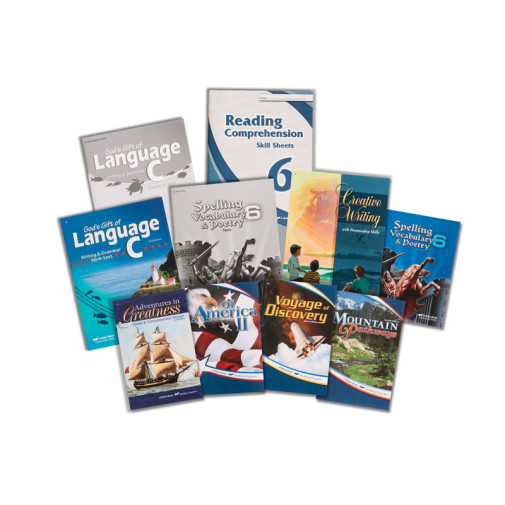We use cookies to make your experience better. To comply with the new e-Privacy directive, we need to ask for your consent to set the cookies. Learn more.
Language Arts 6 Child Kit (3rd Edition)
Language Arts Grade 6 cements the elementary skills in preparation for upper-level Abeka courses. Child Kits contain the texts, readers, and all essential materials. Program requires both Parent and Child Kits.
The Abeka language arts program integrates and balances the learning of language subject matter with the growth of language skills. Grammar, word usage, mechanics, spelling, vocabulary, and reading build from year to year and then are practiced and reviewed thoroughly. Your child will further improve the skills of cursive writing, oral reading and interpretation, reading with speed and comprehension, clear and correct oral and written communication, and logical thinking. The Grade 6 Language Arts Child Kit contains texts and correlated assessments for the entire grade 6 language arts program—11 items total. (Also highly recommended are the novels Message of the Mountain and Billy Sunday for book reports, sold separately.) Combine this kit with the Grade 6 Language Arts Parent Kit, and you can confidently teach and guide your sixth grader through a year of academic excellence in language arts. He will have built a solid foundation for lifelong learning and success and be well prepared for junior high.
Kit Features
* Reading—Classic works by Kipling, Twain, Alcott are just some of the stories and poems that will present your child with literary beauty, Christian ideals, and spiritual values. Thinking skills and comprehension skills continue to be a part of the Abeka reading program.
* Grammar and Composition—Creative writing and report writing provide practical applications as your child builds a grammar, usage, and mechanics foundation that will serve him well in junior high.
* Spelling, Vocabulary, and Poetry—Your child's spelling skills and oral and written vocabulary will grow quickly through his work with English words formed with Greek and Latin roots and prefixes and suffixes. Activities in proofreading and learning about the development of English language are an added bonus! And what an accomplishment when he can recite from memory all 8 poems!
* Penmanship—A review of cursive writing is tied in with Creative Writing, the special companion book to Language C.
Language arts programs listed in this section cover most areas of language arts (reading/literature, writing, grammar, spelling and handwriting) in one curriculum, although some skill areas may be covered with less intensity than a focused, stand-alone course.
The Abeka® distinctives start very early and flow through all levels, such as a cursive-first handwriting approach (starts in K and reviewed up to 6), thorough grammar (with diagramming), foundation-based composition skills (begins in 1st grade) and listening/speaking skills (including reading aloud and poetry memorization). All with Christian, patriotic-focused content in a spiral format with detailed teacher instruction. In 1st grade, skills introduced in previous years (phonics/reading, optional cursive, poetry, and vocabulary skills) are enriched with creative writing and sentence-level mechanics, weekly spelling tests, and oral reading. In Grade 2, transition to reading comprehension and beginning literature analysis occurs. Grade 3 begins the four-pronged emphasis of reading skills (analysis & discussion), writing (academic & creative), spelling/poetry, and grammar. Grade 4 (Level A) adds speed reading, the writing process, researching, and diagramming. Students refine all skills in Grade 5 (B), aiming for varied reading and writing (emphasizing research skills), as they head for Grade 6 (C), which cements the elementary skills in preparation for Abeka® upper-level courses.
Abeka® Language Arts Grade 6 (Level C) cements the elementary skills in preparation for Abeka® upper-level courses. A complete Language Arts program requires both a Child and a Parent Kit. Child Kits contain the texts, readers, and all essential materials. Parent Kits include full lesson plans, answer keys, and level-based required materials. Additional lesson plans, student consumables, and reinforcement/enrichment ELA items are available on the Rainbow Resource website.
| Product Format: | Paperback |
|---|---|
| Brand: | A Beka Book |
| Grade: | 6 |
| Length in Inches: | 3 |
| Width in Inches: | 13.25 |
| Height in Inches: | 10.375 |
| Weight in Pounds: | 8 |

